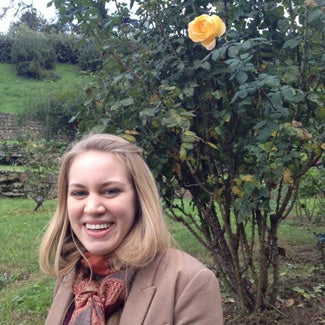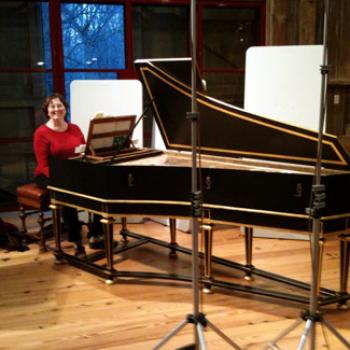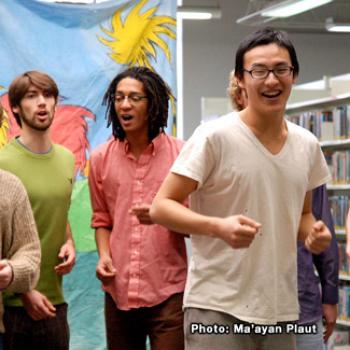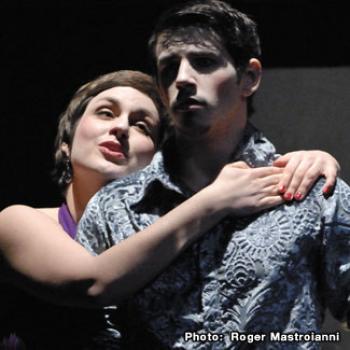On choosing an Oberlin path
Brenna Larson ’14
“My Oberlin career, like many, has been far from linear, and I am glad that I have strayed from my plan. A planner at heart, changing gears, changing life goals, was a rocky and emotional process, and one I would not undo.”

Entering my first year at Oberlin, I had every intention of reapplying to the conservatory as a violinist. Ever since I made the first draft of my college list, being part of Oberlin’s Double Degree Program was the greatest indicator of personal and academic success.
I arrived on campus as a college student, the weight of the conservatory rejection weighing heavily, and signed up and auditioned for secondary lessons. Far from alone, I auditioned along with many other college students, a mix of aspiring connies (as conservatory students are affectionately known on campus) and, more typically, students simply looking to improve their musical prowess while earning a bit of course credit. Secondary lessons are awarded to most, if not all, who sign up, a few students working with conservatory professors depending on logistics, and the rest learning from advanced conservatory students. Working with a professor was, in my mind, a necessary step to successfully auditioning into the conservatory, and I was disappointed by my placement with a student.
I arrived at my first lesson with Holly Jenkins on a warm fall afternoon. I was greeted in the conservatory lounge in the warm and awkward way of first meetings and accompanied up to the practice room. Thus began, perched on the windowsill next to the grand piano, the first of our many heart-to-hearts, initially talking about disappointments, aspirations, and attainable goals, and later about most everything. And after our first debriefing, I delved into the Mendelssohn violin concerto with conservatory auditions forefront on my mind.
Holly worked with me every week, always generous with her time, and proved to be a pedagogical force; she taught me creatively and energetically, broke me of years-long habits and forced me to listen, more carefully than perhaps I ever had, to the subtleties of the music I was producing. Through her I saw the world and life of a conservatory violinist of the highest caliber. I lived vicariously through her and relied on her as my greatest support.
Sometime nearing the end of fall semester, or perhaps it was in the early spring, I realized that I no longer craved the conservatory or its rows of occupied practice rooms and tall prism shaped windows. I had accomplished a great deal in a semester of lessons with Holly, and I was proud of what I had done in a number of respects. I had performed at a recital, maintained a diligent practice schedule, and had truly improved. I was ready, if I so chose, to prepare an audition.
Yet in those months I began to see myself differently. For the first time I was a student away from the context of violin, away from the constant self-reflection, and what had for me had become nagging and brutal self criticism that equaled the path to a career in music. I realized for the first time that I was happier and more self-assured without the pressure of “making it.” I reached the epiphany that making music is integral to my identity, but competitive success in the field did not, despite all I had told myself as a high school student, determine my happiness.
I began Oberlin with an idea of my graduation already firmly in place: a five-year run of violin and college studies, wrapped up neatly, a success for myself and my teachers, both musical and academic, back home. My Oberlin career, like many, has been far from linear, and I am glad that I have strayed from my plan. A planner at heart, changing gears, changing life goals, was a rocky and emotional process, and one I would not undo. My academic path would have thoroughly confused my first-year self. Now, I am an art history major with graduate school and museum career aspirations, and I take my greatest joy and energy from long and productive periods of research and art viewing.
I was challenged at a most fundamental level upon my arrival in this small Ohio town; Oberlin forced me to look hard at the paths in front of me and to evaluate whom I want to be and what path will make me happiest. But through the challenge of vigorous introspection, I gained a great friend in Holly, a person I continued to study with through my second year and with whom I keep in regular contact as she finishes a masters program in New York. The narrative of critical self-analysis and deep friendships had woven through my Oberlin experience and shaped the direction of my life, all for the better.
Tags:
You may also like

In summarizing her many Oberlin memories
“There is so much to do and learn at Oberlin... if you are admitted, choose Oberlin; when there, take as many different courses as you can, meet as many people as possible.”
Karen Gebhart Flint ’64

On singing with the Obertones
“But as I would realize, this love was a postulate of the Obertones; something so obvious it needed no proof through audible declaration. Everyone in the Obertones loves to sing.”
Kevin Hu ’11

On playing Poppea
“It’s still hard to believe that as a lowly undergrad, I got the chance to play Poppea - opera’s earliest gold digger - and find the music that truly fits my voice.”
Lillie Chilen ’08